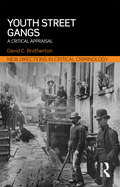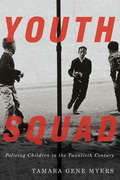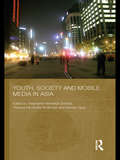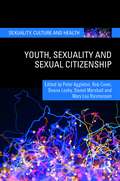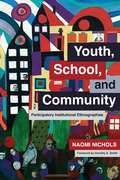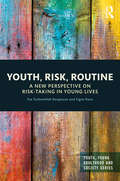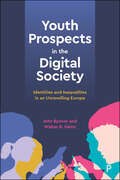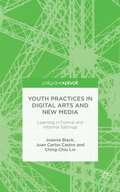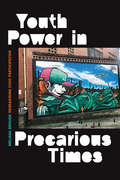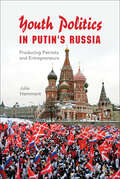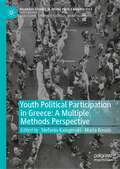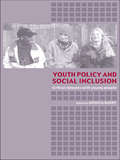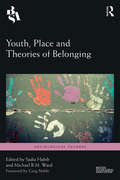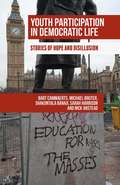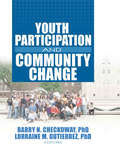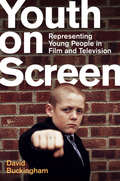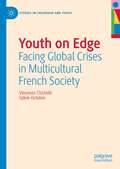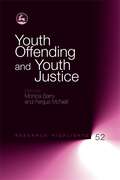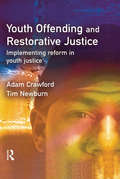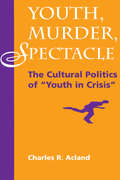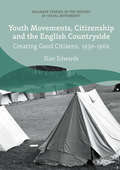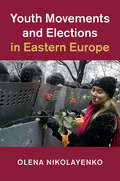- Table View
- List View
Youth Subcultures in Fiction, Film and Other Media: Teenage Dreams (Palgrave Studies In The History Of Subcultures And Popular Music Ser.)
by Beth Johnson Nick Bentley Andrzej ZieleniecThis collection explores the representation, articulation and construction of youth subcultures in a range of texts and contexts. It brings together scholars working in literary studies, screen studies, sociology and cultural studies whose research interests lie in the aesthetics and cultural politics of youth. It contributes to, and extends, contemporary theoretical perspectives around youth and youth cultures.Contributors examine a range of topics, including ‘bad girl’ fiction of the 1950s, novels by subcultural writers such as Colin MacInnes, Alex Wheatle and Courttia Newland, as well as screen representations of Mods, the 1990s Rave culture, heavy metal, and the Manchester scene. Others explore interventions into subcultural theory with respect to metal, subcultural locations, abjection, graffiti cultures, and the potential of subcultures to resist dominant power frameworks in both historical and contemporary contexts.
Youth Street Gangs: A critical appraisal (New Directions in Critical Criminology)
by David C. BrothertonGangs have been heavily pathologized in the last several decades. In comparison to the pioneering Chicago School's work on gangs in the 1920s we have moved away from a humanistic appraisal of and sensitivity toward the phenomenon and have allowed the gang to become a highly plastic folk devil outside of history. This pathologization of the gang has particularly negative consequences for democracy in an age of punishment, cruelty and coercive social control. This is the central thesis of David Brotherton’s new and highly contentious book on street gangs. Drawing on a wealth of highly acclaimed original research, Brotherton explores the socially layered practices of street gangs, including community movements, cultural projects and sites of social resistance. The book also critically reviews gang theory and the geographical trajectories of streets gangs from New York and Puerto Rico to Europe, the Caribbean and South America, as well as state-sponsored reactions and the enabling role of orthodox criminology. In opposition to the dominant gang discourses, Brotherton proposes the development of a critical studies approach to gangs and concludes by making a plea for researchers to engage the gang reflexively, paying attention to the contradictory agency of the gang and what gang members actually tell us. The book is essential reading for academics and students involved in the study of juvenile delinquency, youth studies, deviance, gang studies and cultural criminology.
Youth Squad: Policing Children in the Twentieth Century
by Tamara MyersStarting in the 1930s, urban police forces from New York City to Montreal to Vancouver established youth squads and crime prevention programs, dramatically changing the nature of contact between cops and kids. Gone was the beat officer who scared children and threatened youth. Instead, a new breed of officer emerged whose intentions were explicit: befriend the rising generation. Good intentions, however, produced paradoxical results. <p><p>In Youth Squad Tamara Gene Myers chronicles the development of youth consciousness among North American police departments. Myers shows that a new comprehensive strategy for crime prevention was predicated on the idea that criminals are not born but made by their cultural environments. Pinpointing the origin of this paradigmatic shift to a period of optimism about the ability of police to protect children, she explains how, by the middle of the twentieth century, police forces had intensified their presence in children's lives through juvenile curfew laws, police athletic leagues, traffic safety and anti-corruption campaigns, and school programs. The book describes the ways that seemingly altruistic efforts to integrate working-class youth into society evolved into pervasive supervision and surveillance, normalizing the police presence in children's lives. <p><p>At the intersection of juvenile justice, policing, and childhood history, Youth Squad reveals how the overpolicing of young people today is rooted in well-meaning but misguided schemes of the mid-twentieth century.
Youth Squad: Policing Children in the Twentieth Century
by Tamara Gene MyersStarting in the 1930s, urban police forces from New York City to Montreal to Vancouver established youth squads and crime prevention programs, dramatically changing the nature of contact between cops and kids. Gone was the beat officer who scared children and threatened youth. Instead, a new breed of officer emerged whose intentions were explicit: befriend the rising generation. Good intentions, however, produced paradoxical results. In Youth Squad Tamara Gene Myers chronicles the development of youth consciousness among North American police departments. Myers shows that a new comprehensive strategy for crime prevention was predicated on the idea that criminals are not born but made by their cultural environments. Pinpointing the origin of this paradigmatic shift to a period of optimism about the ability of police to protect children, she explains how, by the middle of the twentieth century, police forces had intensified their presence in children's lives through juvenile curfew laws, police athletic leagues, traffic safety and anti-corruption campaigns, and school programs. The book describes the ways that seemingly altruistic efforts to integrate working-class youth into society evolved into pervasive supervision and surveillance, normalizing the police presence in children's lives. At the intersection of juvenile justice, policing, and childhood history, Youth Squad reveals how the overpolicing of young people today is rooted in well-meaning but misguided schemes of the mid-twentieth century.
Youth, Society and Mobile Media in Asia (Media, Culture and Social Change in Asia)
by Stephanie Hemelryk DonaldThis book examines the influence of mobile media technology on the lives of young people in East and North Asia, South East Asia and Australia. It discusses the impact information communication technologies have today on social identity, well-being, participation and exclusion. It explores current media practices and their innovative, transformative and disruptive uses at the local, the regional, the national, and the global level. In particular, it analyses mobile media not as a discrete object, but rather as part of a dynamic communication and information environment in which human-object relations are constantly reconfigured. It covers key theoretical and conceptual themes in youth mobile media research focusing on social, cultural and political aspects, including coverage of key themes such as regulation and technology, practices, pedagogies, aesthetics, social change, and representations of mobile youth. The book includes new accounts of recent research into the uses of mobile media by young people, and how these are situated in a broader socio-political context. Case studies include mobile panics in Australia (the notorious Kings of Wirrabee sexual assault case) and Japan (the scandals of high school girls as teenage prostitutes) in which mobile media use has had significant impact. This book offers an up-to-date examination of the influence of information communication technologies on young people’s lives in the region.
Youth, Sexuality and Sexual Citizenship (Sexuality, Culture and Health)
by Peter Aggleton Rob Cover Deana Leahy Daniel Marshall Mary Lou RasmussenSexual citizenship is a powerful concept associated with debates about recognition and exclusion, agency, respect and accountability. For young people in general and for gender and sexually diverse youth in particular, these debates are entangled with broader imaginings of social transitions: from ‘child’ to ‘adult’and from ‘unreasonable subject’ to one ‘who can consent’. This international and interdisciplinary collection identifies and locates struggles for recognition and inclusion in particular contexts and at particular moments in time, recognising that sexual and gender diverse young people are neither entirely vulnerable nor self-reliant. Focusing on the numerous domains in which debates about youth, sexuality and citizenship are enacted and contested, Youth, Sexuality and Sexual Citizenship explores young people’s experiences in diverse but linked settings: in the family, at school and in college, in employment, in social media and through engagement with health services. Bookended by reflections from Jeffrey Weeks and and Susan Talburt, the book’s empirically grounded chapters also engage with the key debates outlined in it's scholarly introduction. This innovative book is of interest to students and scholars of gender and sexuality, health and sex education, and youth studies, from a range of disciplinary and professional backgrounds, including sociology, education, nursing, social work and youth work.
Youth, School, and Community: Participatory Institutional Ethnographies (G - Reference, Information And Interdisciplinary Subjects Ser.)
by Naomi NicholsUnlike other books about youth, this book examines how young people’s experiences of inclusion and exclusion are shaped by extended social relations, coordinating thought and conduct across time and space. Working with young people, using a range of participatory institutional ethnographic strategies, this book investigates the social and institutional relations which differentially punctuate our lives. While research began with what young people know and have experienced, this starting place anchors an investigation of public sector institutions and institutional processes that remain implicated in social-historical-economic processes of global capitalism, imperialism, and colonialism. Youth, School, and Community connects the dots between the abstract objectified accounts produced by institutions and enabling institutional action and accounting practices, and the actual material conditions of young people’s lives and development, which these accounts obscure. By focusing on specific policies and procedures that produce young people’s experiences of racialized inclusion/exclusion, safety/risk make it particularly useful to academics, professionals, and activists who want to ensure that young people experience equitable access to public sector resources and not disproportionate exposure to public sector punishments and punitive interventions.
Youth, Risk, Routine: A New Perspective on Risk-Taking in Young Lives (Youth, Young Adulthood and Society)
by Tea Torbenfeldt Bengtsson Signe RavnYoung people’s lives continue to be the topic of public scrutiny and recurring ‘moral panics’. Smoking cannabis, speeding, and engaging in street-level fights are depicted as activities based on ‘poor choices’ or simple hedonism, putting young people’s futures at risk. Based on comprehensive, qualitative research with young people in Denmark, this book illustrates how such individualised accounts miss out on the inherently social character of risk-taking activities. Youth, Risk, Routine introduces a new approach to risk-taking activities as being an integral and routinised part of young people’s everyday life. By applying social theories of practice, this insightful volume presents a framework for understanding the routinised dimensions of young people’s engagement in risk-taking and how this is embedded in, intertwined with, and held in place by other everyday practices. Indeed, through extensive empirical analyses of the rich material at hand, the authors explore how routinisation, coordination, embodiment, and social context are central aspects for understanding how, why, and when young people engage in risk-taking practices. Youth, Risk, Routine will be of interest to students and scholars in sociology, criminology, and social work as well as wider social science audiences, particularly those interested in exploring the empirical potential of social theories of practice.
Youth Prospects in the Digital Society: Identities and Inequalities in an Unravelling Europe
by John Bynner Walter HeinzIn an age when the next generation have worse prospects than those of their parents, this book appraises the challenges young people face resulting from the instability of their lives. Based on youth experience of education, employment and political participation in England and Germany, the book examines the impact of digitalisation in the context of rising inequality, accelerating technological transformation, fragile European institutions, growing nationalism and mental and economic stress arising from the COVID-19 pandemic. The insights gained point to young peoples’ agency as central to acquiring the skills and resources needed to shape their future in the digital society.
Youth Practices in Digital Arts and New Media: Learning in Formal and Informal Settings
by Joanna Black Juan Carlos Castro Ching-Chiu LinThe authors examine youths' practices in digital culture affecting social change, pedagogy, and creative learning practices. Knowledge about these practices is discussed, in which learning, knowledge sharing, distinct social contexts, pedagogical relationships, and artistic creative inquiry are examined in diverse formal and informal environments.
Youth Power in Precarious Times: Reimagining Civic Participation
by Melissa BroughDoes youth participation hold the potential to change entrenched systems of power and to reshape civic life? In Youth Power in Precarious Times Melissa Brough examines how the city of Medellín, Colombia, offers a model of civic transformation forged in the wake of violence and repression. She responds to a pressing contradiction in the world at large, where youth political participation has become a means of commodifying digital culture amid the ongoing disenfranchisement of youth globally. Brough focuses on how young people's civic participation online and in the streets in Medellín was central to the city's transformation from having the world's highest homicide rates in the early 1990s to being known for its urban renaissance by the 2010s. Seeking to distinguish commercialized digital interactions from genuine political participation, Brough uses Medellín's experiences with youth participation—ranging from digital citizenship initiatives to the voices of community media to the beats of hip-hop culture—to show how young people can be at the forefront of fostering ecologies of artistic and grassroots engagement in order to reshape civic life.
Youth Politics in Putin's Russia: Producing Patriots And Entrepreneurs (New Anthropologies of Europe)
by Julie HemmentJulie Hemment provides a fresh perspective on the controversial nationalist youth projects that have proliferated in Russia in the Putin era, examining them from the point of view of their participants and offering provocative insights into their origins and significance. The pro-Kremlin organization Nashi ("Ours") and other state-run initiatives to mobilize Russian youth have been widely reviled in the West, seen as Soviet throwbacks and evidence of Russia's authoritarian turn. By contrast, Hemment's detailed ethnographic analysis finds an astute global awareness and a paradoxical kinship with the international democracy-promoting interventions of the 1990s. Drawing on Soviet political forms but responding to 21st-century disenchantments with the neoliberal state, these projects seek to produce not only patriots, but also volunteers, entrepreneurs, and activists.
Youth Political Participation in Greece: A Multiple Methods Perspective (Palgrave Studies in Young People and Politics)
by Stefania Kalogeraki Maria KousisThe overarching aim of this edited volume is to investigate different modes, patterns and determinants of youth political participation in Greece, since the economic crisis, by incorporating a variety of quantitative and qualitative methods. The chapters examine different forms of youth political participation, from institutionalized (such as voting, or membership in political parties) to non-institutionalized (such as signing petitions, protesting through demonstrations or occupations, and political consumerism). Moreover, the chapters shed light on diverse aspects of youth political participation, such as the interlinkages between occupational precarity and political behaviour, the spatial portrait of youth political engagement in rural, suburban and urban Greek contexts, the engendered aspects of political involvement, the pivotal role of protest events in youth political socialization and in mobilization in contentious political actions, the different impacts of priming inequality on youth’s political beliefs, depending on different modes of thinking, as well as the key features of youth-related and youth-led (non-state) organisations operating in Greece. The aforementioned aspects are examined at the micro, meso or/and macro level through distinct methodological approaches including panel survey, experimental survey, biographical interviews, in-depth interviews and action organization analysis, carried out in the context of the EURYKA (European Commission) project.
Youth Policy and Social Inclusion: Critical Debates with Young People
by Monica BarryTaking a holistic and multidisciplinary approach this book identifies and analyzes the factors which promote or discourage social inclusion of young people in today’s society. It critically examines the discriminatory attitudes towards young people, and focuses on the 'problem' of adults rather than the 'problem' of young people themselves. The authors ask searching questions about society's capacity and willingness to be more socially inclusive of young people in terms of policy and practice, and explore the extent to which young people have access to status, rights and responsibilities as young adults. Challenging existing theory the book covers issues including: citizenship, education, rights, youth transactions, drug use, homelessness, teenage pregnancy and unemployment. Incorporating the views and experiences of young people themselves, the book highlights the strengths and weaknesses of the academic contribution and suggests ways forward for a more inclusive society.
Youth, Place and Theories of Belonging (Sociological Futures)
by Sadia Habib Michael R. M. Ward Greg NobleDrawing on interdisciplinary perspectives, Youth, Place and Theories of Belonging showcases cutting-edge empirical research on young people’s lifeworlds. The scholars demonstrate that belonging is personal, infused with individual and collective histories as well as interwoven with conceptions of place. In studying how young people adapt to social change the research highlights the plurality of belonging, as well as its temporal and fleeting nature. In the field of youth studies, we have seen a recent emphasis on studying the ways youth live out everyday multiculturalisms in an increasingly globalised world. How young people negotiate belonging in everyday life and how they come to understand their positions in fragmented societies remain emerging areas of scholarship. Composed of twelve chapters, the collection references key sites and institutions in young people’s lives such as schools, community/cultural centres, neighbourhoods and spaces of consumption. Drawing from diverse areas such as the rural, the urban as well as displacements and mobilities, this international collection enhances our understanding of the theories employed in the study of youth identity practices. Written in a direct and clear style, this collection of essays will be of interest to researchers working in geography, theories of affect, gender, mobility, performativities, and theories of space/place. Investigating how young people come to belong can open up new spaces and provide critical insights into young people’s identities.
Youth Participation in Democratic Life: Stories of Hope and Disillusion
by Bart Cammaerts Michael Bruter Shakuntala Banaji Sarah Harrison Nick Anstead Whitwell ByrtThis book is concerned with the contexts, nature and quality of the participation of young people in European democratic life. The authors understand democracy broadly as both institutional politics and civic cultures, and a wide range of methods are used to analyse and assess youth participation and attitudes.
Youth Participation and Community Change
by Barry CheckowayEmpowered youth CAN and DO make a difference!Young people become empowered by their participation in the institutions and decisions that affect their lives-which in turn can lead to real positive change in the community. Youth Participation and Community Change presents leading authorities providing the latest research and effective approaches on how young people can be drawn to participate in organizations and communities. The diverse perspectives discuss youth participation in today&’s society, the models and methods of its practice, the roles of youth and adults, and the future of youth participation and community in a diverse democracy. Approaches include those which promote participatory community-based research and evaluation, and involve youth groups in poor and racially segregated areas.The mainstream view of much of today&’s youth is that of being victims of society rather than a being a possible positive influence on society as a whole. Youth Participation and Community Change seeks to shift the viewpoint from youth as being problems to empowering them to enact positive social change. The book explores community agency efforts to involve young people, and the process by which youth civic engagement promotes empowerment. Social work and public health approaches are examined, with cogent discussions on conceptual and theoretical issues. Empirically based case studies illustrate best practices and interdisciplinary work that draws upon psychology, sociology, social work, public health, education, and related academic disciplines and professional fields.Topics in Youth Participation and Community Change include: key dimensions of critical youth empowerment a case study of youth leadership development in Hawaii-the Sariling Gawa Youth Council the Lexington Youth Leadership Academy-a leadership development and community change program a new model for youth civic engagement in Hampton, Virginia three projects that engage urban youth in community change through participatory research youth engagement strategies and the benefits of youth participation in health research ten projects which used photovoice to represent, advocate, and enhance community health a participatory action research process with youth in Bosnia and Herzegovina the Growing Up in Cities project of UNESCO training students as facilitators for the Youth Empowerment Strategies (YES!) project four characteristics of engagement in the research literature and a school-community-university project differences in developmental outcomes among youth organizing, identity-support, and traditional youth development agenciesYouth Participation and Community Change is thought-provoking, enlightening reading that is perfect for organizers, planners, policymakers, advocates, youth service workers, agency administrators, educators, students, and professionals in psychology, sociology, social work, urban planning, public policy, and public health.
Youth on Screen: Representing Young People in Film and Television
by David BuckinghamRight from the origins of cinema, countless films and television dramas have offered sensational and seductive representations of young people's lives. Youth is typically associated with energy, idealism and physical beauty, but it is often represented as both troubled and troubling. These representations are almost always created by adults, implicitly reflecting an adult perspective on how young people 'come of age'. Youth on Screen provides a historical account of representations of youth in Britain and the United States, stretching back over seventy years. From Blackboard Jungle to This is England, and from Jailhouse Rock to Skins, it covers a range of classics, as well as some intriguing obscurities. Engagingly written and clearly organized, it offers a perfect introduction for students and general readers.
Youth on Edge: Facing Global Crises in Multicultural French Society (Studies in Childhood and Youth)
by Vincenzo Cicchelli Sylvie OctobreThis book explores disrupted youth cohesion in France within the context of multiple ongoing global economic, migratory, social, political, and security-related crises. While these trends can be observed in numerous Western societies, France provides a unique case study of various anti-cosmopolitan and anti-Enlightenment movements shaping youth conditions and reconfiguring relationships between the individual, the group, and society. The authors undertook in-depth interviews with French young people between the ages of 18 to 30 years old to inquire into how they experience "vivre ensemble" (living together) in a time of rising economic inequalities and multicultural tensions. Through these findings, they invite decision-makers, politicians, educators, and parents to propose a renewed narrative of social cohesion for youth who are not disillusioned, but deeply on edge.
Youth Offending and Youth Justice
by Fergus Mcneill Monica BarryHow is the modern world shaping young people and youth crime? What impact is this having on the latest policies and practice? Are current youth justice services working? With contributions from leading researchers in the field, this book offers an insightful, scholarly and critical analysis of such key issues. Youth Offending and Youth Justice engages constructively with current policy and practice debates, tackling issues such as the criminalisation and penalisation of youth, sentencer decision-making, the incarceration of young people and the role of public opinion. It also features an applied focus on professional practice. Drawing on a wide range of high-quality research, this book will enrich the work of practitioners, managers, policy-makers, students and academics in social work, youth work, criminal justice and youth justice in the UK and beyond.
Youth Offending and Restorative Justice
by Adam Crawford Tim NewburnThis book provides an empirically grounded, theoretically informed account of recent changes to the youth justice system in England and Wales, focusing on the introduction of elements of restorative justice into the heart of the criminal justice system, and the implementation of referral orders and youth offender panels. Taken together, this amounts to the most radical overhaul of the youth justice system in the last half century, fundamentally changing the underlying values of the system away from an 'exclusionary punitive justice' and towards an 'inclusionary restorative justice'. The book explores the implications of these changes by using the lens of a detailed study of the implementation of referral orders and youth offender panels to explore wider issues about youth justice policy and the integration of restorative justice principles. It draws upon the findings of an in-depth study of the pilots established prior to the national rollout of referral orders in April 2002. The book will be essential reading not only for those involved in the task of implementing the new youth justice, but others with an interest in the criminal justice system and in restorative justice who need to know about the far reaching reforms to the youth justice system and their impact.
Youth, Murder, Spectacle: The Cultural Politics Of ""Youth In Crisis"" (Cultural Studies)
by Charles R AclandFirst Published in 2018. Routledge is an imprint of Taylor & Francis, an Informa company.
Youth, Multiculturalism and Community Cohesion
by Paul ThomasSince the 2001 'race riots' in the north of England, and the 7/7 London bombings, Britain has appeared to reject multiculturalism. It has instead prioritized a new policy of 'Community Cohesion' that calls for a focus on common needs and shared British identity, rather than on ethnic and religious differences. This has proved a controversial agenda, apparently downplaying the reality of racism and ethnic diversity, and leading to one critic calling it 'the death of multiculturalism'. Little evidence has emerged so far on what Community Cohesion actually represents, but this book addresses that deficit by drawing on empirical research around work with young people to analyse the meaning and practice of British Community Cohesion policies, youth identities in racially-tense areas, and government's attempts to 'prevent violent extremism' amongst young Muslims. It concludes that Community Cohesion is a new phase of multiculturalism, not its death.
Youth Movements, Citizenship and the English Countryside: Creating Good Citizens, 1930-1960 (Palgrave Studies in the History of Social Movements)
by Sian EdwardsThis book explores the significance and meaning of the countryside within mid-twentieth century youth movements. It examines the ways in which the Boy Scouts, Girl Guides, Woodcraft Folk and Young Farmers' Club organisations employed the countryside as a space within which 'good citizenship' - in leisure, work, the home and the community - could be developed. Mid-century youth movements identified the 'problem' of modern youth as a predominantly urban and working class issue. They held that the countryside offered an effective antidote to these problems: being a 'good citizen' within this context necessitated a respectful and mutually beneficial relationship with the rural sphere. Avenues to good citizenship could be found through an enthusiasm for outdoor recreation, the stewardship of the countryside and work on the land. However, models of good citizenship were intrinsically gendered.
Youth Movements and Elections in Eastern Europe (Cambridge Studies in Contentious Politics)
by Olena NikolayenkoAt the turn of the twenty-first century, a tide of nonviolent youth movements swept across Eastern Europe. Young people demanded political change in repressive political regimes that emerged since the collapse of communism. The Serbian social movement Otpor (Resistance) played a vital role in bringing down Slobodan Milosevic in 2000. Inspired by Otpor's example, similar challenger organizations were formed in Azerbaijan, Belarus, Georgia, and Ukraine. The youth movements, however, differed in the extent to which they could mobilize citizens against the authoritarian governments on the eve of national elections. This book argues that the movement's tactics and state countermoves explain, in no small degree, divergent social movement outcomes. Using data from semi-structured interviews with former movement participants, public opinion polls, government publications, non-governmental organization (NGO) reports, and newspaper articles, the book traces state-movement interactions in five post-communist societies: Azerbaijan, Belarus, Georgia, Serbia, and Ukraine. Uses data from interviews with former movement participants, public opinion polls, government publications, non-governmental organization (NGO) reports, and newspaper articles. Provides a comparative analysis of state-movement interactions in five post-communist societies: Azerbaijan, Belarus, Georgia, Serbia, and Ukraine. Highlights a record of civic activism in the selected countries, and unravels the significance of learning from prior protest campaigns.

